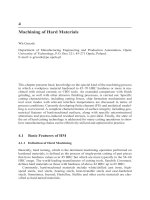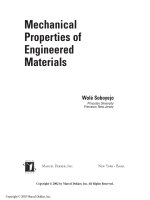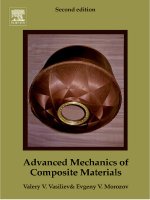chemistry of energetic materials (miller)
Bạn đang xem bản rút gọn của tài liệu. Xem và tải ngay bản đầy đủ của tài liệu tại đây (9.44 MB, 225 trang )
Richard S- Miller
Dr. Richard S, Miller is recognized both as a scientist and as a manager
in the
Office of Naval
Research.
His contributions to this field well illustrate the role
and value of federal support in nurturing innovative science. Dick Miller is a model
for the perfect federal science manager; technically brilliant, adroit in assembling
novel yet balanced
programs,
and most of all entirely dedicated to the welfare of the
scientists and graduate students whose research fulfills his mission. As a result of
Dr. Miller's efforts, the Navy has benefited from tremendous new knowledge of
energetic materials.
The articles in this volume provide an overview of the field where Dr. Miller
has had such a great influence. The contributions in this critical and rapidly grow-
ing area of science have profoundly benefited the advancement of knowledge as
well as our national defense. The quality of the contributions herein and the emi-
nence of the investigators clearly testifies that the study of energetic materials is
no longer only of great practical significance but has also achieved high standing
as an area of fundamental scholarly research.
We dedicate this volume to Dick Miller as a scientist, a faithful provider of
federal funding for science, and a brilliant manager of technology for our future
Navy.
OJ
F.
E. Saalfeld
Director Office of
Naval Research
Chemistry
of
Energetic Materials
Edited by
George A. Olah
Loker
Hydrocarbon Research Institute
Department
of Chemistry
University
of
Southern California
Los
Angeles,
California
David R. Squire
Defense Sciences Office
DARPA
Arlington, Virginia
I
This book is printed on acid-free paper. ©
No Rights Reserved.
All parts of this publication maybe reproduced or transmitted in any form or
by any means, electronic or mechanical, including photocopy, recording, or
any information storage and retrieval system.
Library of Congress Cataloging-in-Publication Data
Chemistry of energetic materials / (edited by) George A. Olah, David
R. Squire
p.
cm.
Includes index.
ISBN
0-12-525440-7
t. Combustion. 2. Thermodynamics. 3. Explosives.
4.
Propellants. I. Olah, George A. (George Andrew), date
U. Squire, David R.
QD516.C538 1991
541.361
91-12536
C1P
5 4 3 2
Contents
Contributors vii
Preface ix
1.
The Structural Investigation of Energetic Materials 1
Richard
D.
Gilardi and
Jerome
Karle
I. Introduction 1
II.
Pressure and Impulse 2
III.
Energetic Materials Database 3
IV. Bending Angles in Nitramines 6
V. Nitroolefins 11
VI.
Cubane and Substituents 16
VII.
Conclusions 22
References 23
2.
Studies of Initial Dissociation Processes in
1,3,3-
Trinitroazetidine by Photofragmentation Translational
Spectroscopy 27
Deon
S.
Anex, John C. Allman, and
Yuan
T.
Lee
I. Introduction and Overview 27
II.
The Thermal Decomposition of TNAZ 33
III.
Analysis and Discussion 42
IV. Summary 53
Referenees/Endnotes 54
3.
Studies of Molecular Dissociation by Means of Ultrafast
Absorption and Emission Spectroscopy and Picosecond X-Ray
Diffraction 55
Peter
M.
Rentzepis
and
B.
Van Wonterghem
I. Introduction 55
II.
Photodissociation of Haloaromatics 56
III.
Picosecond X-Ray Diffraction 69
References 75
4.
Computer-Aided Design of Monopropellants 77
Peter
Polttzer,
Jane
S.
Murray,
M.
Edward
Grice,
and Per Sjoberg
I. Introduction 77
Contents
vi
II Theoretical Background
78
£ AjicanonofSpecificImpulseFormula
80
IV Calculated Specific Impulse Values
81
V. Perspectives
91
VI.
Summary
92
References
92
5.
Polycyclic Amine Chemistry
95
AmaidT.
Nielsen
I. Introduction
95
#
II.
Approaches to Synthesis of Caged Nitramine Explosives
97
III.
Polyazaadamantanes
100
IV. Polyazawurtzitanes
104
V. polyazaisowurtzitanes
HO
VI.
Summary
119
References
120
6. Metallacarboranes of the Lanthanide and Alkaline-Earth
Metals: Potential High Energy Fuel Additives 125
Rajesh
Khanar,
KfarkJ.
Manning,
and M. Frederick Hawthorne
I. Lanthanide Element Metallacarboranes
125
II.
Preparation and Characterization
of
Bis-Dicarbollide Complexes
of
Sm and Yb
129
III.
Alkaline-Earth Element Metallacarboranes
131
References
136
7.
Methods for Preparing Energetic Nitro-Compounds: Nitration
with Superacid Systems, Nitronium Salts, and Related
Complexes 139
George
A.
Ohh
I. Introduction
139
II.
Protic-Acid-Catalyzed Nitration
140
HI.
Lewis-Acid-Catalyzed Nitration
152
IV. Nitration with Nitronium Salts
158
V. Transfer Nitration
186
VI.
Dcmetallative Nitration
191
References
198
Index
205
Contributors
Numbers
in
parentheses
indicate
the pages
on which the
authors'
contributions
begin.
John C. Allman (27), Materials and Chemical Sciences Division, Lawrence Berke-
ley Laboratory and Department of Chemistry, University of California,
Berkeley, California 94720
Deon S. Anex (27), Materials and Chemical Sciences Division, Lawrence Berkeley
Laboratory and Department of Chemistry, University of California, Berkeley,
California 94720
Richard
D.
Gilardi (1), Naval Research Laboratory, Washington, D.C. 20375
M. Edward Grice (77), Department of Chemistry, University of New Orleans, New
Orleans, Louisiana 70418
M. Frederick Hawthorne (125), Department of Chemistry and Biochemistry, Uni-
versity of California, Los Angeles, California 90024
Jerome Karle (1), Naval Research Laboratory, Washington, D.C. 20375
Rajesh Khattar (125), Department of Chemistry and Biochemistry, University of
California, Los Angeles, California 90024
Yuan
T.
Lee (27), Materials and Chemical Sciences Division, Lawrence Berkeley
Laboratory and Department of Chemistry, University of California, Berkeley,
California 94720
Mark
J.
Manning
(125),
Department of Chemistry and Biochemistry, University of
California, Los Angeles, California 90024
Jane S. Murray (77), Department of Chemistry, University of New Orleans, New
Orleans, Louisiana 70418
Arnold
T.
Nielsen (95), Chemistry Division, Research Department, Naval Weap-
ons Center, China Lake, California 93555
George A. Olah (139), Loker Hydrocarbon Research Institute, and Department of
Chemistry, University of Southern California, Los
Angeles,
California 900S9
Peter Politzer (77), Department of Chemistry, University of New Orleans, New
Orleans, Louisiana 70418
Peter M. Rentzepis (55), Department of Chemistry, University of California,
Irvine, California 92717
Per Sjoberg (77), Nobel Chemicals, Division Nobelkrut, S-691 85. Kariskoga.
Sweden
B.
Van Wonterghem (55), Department of Chemistry, University of California,
Irvine, California 92717
page.
Preface
The field of energetic materials has long been considered primarily for its practical
aspects and it is only recently that the modern fundamental science phenomena
began to emerge. This has been particularly true in academic science, where fun-
damental acceptance and progress in the field has only recently developed. Ener-
getic materials, however, have been of great practical importance from the time of
the discovery of gunpowder to modern day explosives and rocket fuels. These
materials have had a profound, if not always positive, effect on history. However
the significance of their peaceful
uses,
ranging from the use of explosives in mining
and road building to applications such as missile propulsion systems, should not be
overshadowed by their potential destructive
power.
The ultimate use of the knowl-
edge gleaned by this research is not
a
question for debate here.
Research on energetic materials extends from bulk synthesis, to engineering
and materials science, to the microscopic study of molecular dynamics and struc-
ture (i.e., the molecular level understanding of these systems). In order to under-
stand the combustion of energetic materials, the detailed chemistry of the
decomposition processes must be understood. The nature of the individual reaction
steps,
the dynamics of the dissociation, and the energy released during combustion
reactions must be recognized. Thus, the study of energetic materials spans many
disciplines. Chemistry, as the science that can lead to such materials, is at the focal
point. Indeed, an ever-extending array of new energetic compounds is continually
being synthesized. Historically, nitro derivatives played a special role as the most
commonly used compounds. Energetic nitro compounds range
from
C-nitro
deriv-
atives such as trinitrotoluene (TNT), to
O-nitro
compounds such as trinitrogly-
cerol, to /V-nitro compounds such as HMX and
RDX.
Nitrogen oxides continue to
be significant oxidants.
Any study of energetic materials must clearly start with the characterization of
structure. R. D. Gilardi and J. Karle discuss in the first chapter the structural in-
vestigation of energetic materials by the
use
of single crystal
x-ray
crystallography.
In conjunction with their colleagues at the Naval Research Laboratory, they have
over the years advanced these studies in a remarkable way and in the process
obtained a unique collation of the structural data of more than 500 energetic com-
pounds of great significance. Their chapter centers on the structural study of the
most recent significant classes of
compounds.
In addition to facilitating an under-
standing of
the
relationship of structure
to
function (such
as
density),
this structure*
work also plays a valuable role in the development of new and improved materials
by facilitating synthesis of promising new types of
substances,
as weU as charac-
terizing those already synthesized. It is even possible now, on occasion, to make
Preface
1
he unacr*uu~»*D — ^
his C0
Heagues discuss in ^napicr z
also of fundamentaJ importance^ ^^^ spectroscopy of the significant
their study bv photofragmentatio nitroalkyl nitramine related to the
HVfX and RDX Although a significant portion or the
or enerccuu materials U related to condensed phase reactions, the un-
derstanding of the chemistry of isolated species is also pertinent. Of particular
irion translaiional spectroscope, the compound studied is expanded from a nozzle
,mo a vacuum and the expansion is collimated to form a molecular beam. The
molecular beam is then crossed * ith the output of a pulsed CO
2
laser, which excites
the molecule of interest above the dissociation threshold; this infrared multiphoton
excitation induces dissociation of the molecule. This method has also been applied
previously to the study of the initial steps in RDX decomposition. Molecular beam
studies provide a useful complement to bulk phase decomposition studies. The
characterization of the initial steps in the decomposition allows a better under-
standing of the results of bulk phase studies with regard to secondary reactions and
the role of the condensed state. Molecular beam studies also contribute signifi-
cantly to the theoretical understanding of combustion processes.
P M Remzepis and B. Van Wonterghem discuss in Chapter 3 the kinetics and
mechanism of dissociation of molecules by means of ultrafast absorption and emis-
sion spectroscopy. The spectra of the intermediate states and species are obtained
in real time and the formation and decay of these species measured. The develop-
ment of picosecond x-ray spectroscopy f
PXR),
a new field that enables the record-
ing of
the
evolution of the structure of intermediates durin
2
the course of chemical
reactions,«. also presented. Application of these new pioneering methods to the
study of energetic systems will widen our understanding and knowledge of the
fundamentals of molecular dissociation processes.
' ^leagues discuss the computer-aided design of
on methods that calculate the spe-
lants),
a characteristic es-
propellants. An energetic
per unit weight of the materi-1
s
P
ecihc
impulse /^ is the integral of the thrust,
as a means of charactenzin VnT^ 'l ""^ °
f
^
combuslion
-
h is w
'dely used
culation of specific impulse x,till^tfknow^T^
lechniques all
°
w
'ng the cal-
thus of obvious great sionifi™.^ ° P
ote
ntial energetic molecules are
• r>
U
*
w
"-
l
s
c
«*-
vanu poien-
m Chapter 5 gives an account of the
Preface
—
synthesis of some exciting new and potentially useful polycyclic caged amine*.
After discussing general approaches to the synthesis of caged mtramine explo-
sives,
he presents the chemistry which led to the synthesis of three significant new
classes of caged polycyclic amines, the polyazaadamantanes, polyazawurtzitanes.
and polyazaisowurtzitanes.
R. Khattar and colleagues in Chapter 6 discuss the synthetic and structural
chemistry of the metallacarboranes of the lanthanide and alkaline-earth metals.
These potentially high-energy fuel additives represent a significant addition to the
broad class of metallacarboranes. Their fascinating structural aspects are also of
much interest.
G. A. Olah in Chapter
7
reviews some of
the
most useful methods in preparing
nitro compounds (i.e., electrophilic nitrations with superacid systems, nitromum
salts,
and related Friedel-Crafts type complexes). Polynitro compounds were tra-
ditionally and still are the most widely used explosives [e.g., nitroglycerol. trini-
trotoluene (TNT), and W-nitramines (RDX and HMX)]. Methods of preparing
nitro compounds thus remain a key part of the synthesis of energetic materials.
The study of energetic materials is emerging from a field primarily directed
toward practical interests to an advanced area of fundamental research, where
state-of-the-art methods and theory are used side by side with modern synthetic
methods. That two of the contributors to this volume are Nobel laureates and five
are members of the National Academy of Sciences speaks well for the maturing
nature of the field and the related degree of scientific sophistication. Obviously a
volume of this size cannot give a comprehensive review of the entire field of the
chemistry of energetic materials. It offers, however, a good perspective of the
present day research in both the structural-physicochemical as well as preparative
aspects of the field. The contributions herein should give all practitioners of the
field, whether in academia, industry, or governmental laboratories, a good over-
view of some of the frontlines of the field. It is also hoped that the book will
stimulate young scientists and engineers to take interest in the field of energetic
materials. It is after all the future generation of practitioners who will take over
and build on the present effort to advance the chemistry of energetic materials to
new levels of understanding and improved applications.
The U. S. Navy has traditionally, through its own research at
the
renowned Naval
Research Laboratory and its sponsorship of outside research administered
b>
the
Office of Naval Research, contributed greatly to the development of the field of
energetic materials. One of its most devoted and knowledgeable science adminis-
trators, Dr. Richard Miller, was to a great extent responsible for fostering this
process and this volume is dedicated to him.
George
A.
Olah
David R, Squire
1
The Structural Investigation of Energetic Materials
Richard D. Gilardi and Jerome Karle
I. Introduction
Structure determination in the context of this chapter means the deter-
mination of the atomic arrangements in materials in the crystalline state.
There are a number of aspects to structural analyses. They may be used to
identify substances since they can be performed without previous knowl-
edge of chemical composition. It is possible to determine from structural
analyses the connectedness, conformation, configuration (or absolute con-
figuration under special experimental circumstances), packing, solvent in-
teractions, and average thermal motion associated with the substances of
interest. With careful experimentation in properly chosen cases, electron
density distributions can also be evaluated.
Applications of this type of information in a variety of scientific disci-
plines are evident. Some examples of areas of
science
that can be benefited
are synthetic organic chemistry, natural products chemistry, pharmaceuti-
cal chemistry, the study of rearrangement reactions, reaction mechanisms,
ion transport through biological membranes, and biomolecular engineer-
ing. In addition to facilitating an understanding of the relationship of
structure to function, structural information plays a valuable role in the
development of new and improved materials. It is in this latter context
that the work described in this article was mainly carried out. The predom-
inant purpose was to facilitate the synthesis of improved or new types
of substances, characterize those already synthesized, and on occasion,
make some suggestions concerning the feasibility of certain contemplated
syntheses.
One consequence of the extensive research activity in structural analy-
sis has been the development of a computerized X-ray crystal structure
Chemistry of Energetic Materials
1
Richard D, Gilardi and Jerome Karle
Structural Database [1], containing
tS^^SSf^
chetnical structures
(as of
January
8
?9 n can be searched by computer to provide mformation for use in
tudies of the relation of structure to activity and the design of substances
structures of a large number of energetic materials has provided informa-
tion for an extensive database for such substances [2]. It has served as a
useful source of information for making predictions concerning the possi-
ble success in the synthesis of new materials.
II.
Pressure and Impulse
Density plays an important role in the behavior of energetic materials. The
pressure in explosions and the impulse produced by the same compound
when used as a propellant are related. The Shockwave pressure behind the
detonation front
is
proportional to the density squared [3] times the specific
impulse [4]. The specific impulse itself depends on the volume of gas
produced and the heat of combustion per gram of propellant which leads to
a further complex dependence on density [5]. Thus, the overall depen-
dency of the detonation pressure on the density is greater than quadratic.
Two examples of dense energetic materials are the widely used /3-HMX
and RDX
[6,7],
shown in Fig. 1.
In addition to density, strain also offers the opportunity for higher
^-packn^^
is^^pFamed .moleculejhargil^
number of energetic groups. -^_gnu__contains a large
Fig. 1. Structural diagrams
oS
0-HMX (density = iDn
o
/n^
two wen
;
s,ud
;
cd dense encrge^c con^Uyus° "^
Cde
"
Si
* ~
LW g/CC)
'
ld k
y usea as
expl
;;
ncrge^c
con^Uyus^
*
g/)
'
solid rocket fuels.
y usea as
explosives and as components of
NO,
I
N
NO,
H,C
v
NO
NO,
NO,
P-HMX
2
RDX
/, The Structural Investigation of Energetic Materials
Hexanitrohexa-aza-adamantane Octanitrocubane
O,N
Predicted Density = 2.0-2.2 g/cc Predicted Density = 2.0-2.1 g/cc
Fig. 2. Two major high-energy targets for synthetic chemists.
It is possible to conceive of molecules that contain a large number of
substituted groups and make predictions regarding their density in the
crystalline state [8]. To achieve better results, it is necessary to consider a
number of packing models for various crystallographic space groups [9].
Two substances that have among the highest predicted densities are the
substituted adarrTMTalie~ang~cur5ane sHwrTjn Fig. 2. Xhe_j^iharie_rjuicleus
has,
in addition, its inherent strm^ejiei^iy^^^^rT^
been_synthe_sized [10] and has a density of 1.814 g/cc in the crystalline
state.
To date, three nitro-substituted cubanes have been synthesized, the
di-,
"tri-, and tetra-nitrocubanes
1
which have dejisjtips proportional xo
substrtu^nji^najrnely,
1.66,1.74
and 1,81 g/cc^respec-
III.
Energetic Materials Database
A virtue of developing a database of energetic materials is its use in the
prediction of target structures that have potentially desirable features. The
large number of crystal structure analyses of energetic materials that have
been performed in recent years has provided much useful information.
Examples are structural parameters associated with the NO
2
group, two
NO
2
groups on the same carbon atom, and cage compounds having a
variety of
substituents.
Illustrations of
some
types of compounds that make
up the current database consisting of about 300 compounds are shown in
Fig. 3. An application of the database is the calculation of the structure oi
the hypothetical molecule, octanitrocubane. The predicted distances and
angles are consistent with those in the database and the nitro groups are in
Richard D. Gilardi and Jerome
Karl
NO,
NO
/
-NO,
NO,'
1,3,5,7-Tetranitrocubane A Hexanitropentacycloundecane
O,N
O
2
N
O,N
NO,
A
Tetranitrobishomocub
ane
' '
le
tranitroadamantane
lth
M
M2
[
^
a
he!S
n
t
h
SE
Table I
a
l '
he hy
P°
th
«ical mo
Hexan!," K
draWin
S
of
'he m
of o
M
St nonbonded
°
Ctamtrocu
bane
are shown in
Pointing outward
1.
The Structural Investigation of Energetic Materials
Fig. 4. An energy-minimized model of the hypothetical molecule, octanitrocubane.
from a common center. HNZADA has six N—NO
2
dipoles pointing
outward, but also has four CH dipoles pointing inward, interposed be-
tween the nitro groups, which is electrostatically favorable. Quantum
mechanical calculations on the similar nitramines, HMX and RDX
[16.17].
indicate that the CH dipoles will be much stronger (and thus more stabiliz-
ing) than ordinary aliphatic CH, due to the electron-withdrawing nature of
the many nitramine groups.
A substituted triazaadamantane, 2,4,10-trinitro-2,4,10-triazaadaman-
tane,
was made a few years ago by Nielsen [18]. Its synthesis showed
that a methine (CH) surrounded by nitramines in an adamantane cage
is chemically stable, a matter that had previously been the subject of
debate. There are four such groupings in HNZADA. Otherwise, the local
connections are much the same as in HMX and RDX. Molecular me-
chanics model-building shows that the nitramines are no more crowded
than in HMX and RDX, so there is reason to expect that this target
molecule will not be especially sensitive or readily subject to chemical
deterioration.
An extension of the hypothetical HNZADA is the nonanitraza-target
cage compound shown in Fig. 5. This hypothetical compound has the same
Richard D. Gilardi and
Jerome Kark
0
HMX,
atomic ratios and groupings as HNZADA. On the assumption that
HNZADA and this nonanitraza-compound can be synthesized, it would o
of interest to compare their physical and chemical properties. This is one
example of a large variety of paths that may be followed in the develop-
ment of energetic compounds that have improved characteristics.
IV. Bending Angles in Nitramines
Nitramines are potentially high density materials and are among the types
of substances that have been targeted for synthesis. It has been found
from the database that amino groups in nitramines are rather flexible. The
distribution of the out-of-plane bending angles for the amino group (the
angle between the N-N vector and the C-N-C plane) is illustrated in
Fig. 6. The histogram for the amino bend ranges from 0 to 60°- though
dominated by small [0-20°] angles of bending, one example has been
seen at 59 . N.tro groups, by comparison, are much less flexible, as may
also be seen m Fig. 6 The re evant angle for nitro groups is that between
the N-N vector and the O-N-O plane.
An example of a large amino bend (44.6°) is shown by monoketo RDX
[19]
illustrated in Fig. 7. The carbonyl group has the effect of flattening the
/. The Structural Investigation of Energetic Materials
20
18.
16.
14.
_ 12.
i io.
o
8
6.
4.
2.
0.
•
H
hi
'$. •
m
0 5
Hlitagram of Xj: Arntno Band ~
•
•
mLm__
J9fiHHHfl
^ r 1 r • '^—^^^^^^^-
tO 15 20 25 30 35 4 0 4 5 5 0 55 60
Amino Bend
J||
jy
1 ^H
*1
m
la
0 5 13 '5 ?a 25
Ammo Bend
C2
Nitro Bend
Fig. 6. Frequency distributions for two out-of-plane deformations of the nitramino group.
Fig. 7. The structure of l,3,5,trinitro-2-oxo-l,3,5-triazacyclohexane. The presence of a car-
bony! group flattens the chair-shaped ring and the two nitramines adjacent to it. The third
nitramine displays one of the largest out-of-plane bends yet observed in a nitramine; the N-N
bond is bent 44.6° from the adjacent CNC plane.
04a
Richard
D.
Gilardi
and
Jerome Karle
'013c!
Fig.
8. The structure
of
l-nitro-3-nitratoazetidine.
The
nitramine
is
part
of a
four-membered
ring, and
the N-N
bond
is
bent
out of the
adjacent CNC plane
by
39.6°.
not
T 7
ir-shaped ring and the two nitramine groups near it. Weak forces can
the amino bend since the energies are
configurations. For
indicated that only
-
-
o
—
r
40° out of the C-N-C
bend in l;nitro-3-nitratoa2etidine [21], illustrated in
Ze
oT
Fig 8 is
^ i
^ P
?r
g
A quantum chemical calculation rrn 7 -\ '
trinitroazetidine (see Fig ToTIo
H
'
(US1
"
8 the
pr0
8
ram
MNDO
)
on
™ino bend
(30») was
the mn'™
that 3
^^ out-of-plane
stimulated another MNDO caHlT,
r^,
C
°
nfonnation
-
This
observation
dimethylnitramine shown in FfrlwS!
1
^ *
Simp
'
e model com
P°«nd,
«gy conformation for this molecul u ^
the MNDO
min™um en-
bend could be bent ±20' famflT
l
5
""^'
II
Was fou
"d that the amino
grapw
'
™™
*
y
range agrees
wel1
with the
as shown
mF
Tg
13
individual
I. The Structural Investigation of Energetic Materials
C(4)
0(3)
0(41
n
C(9)
C(8)
Fig. 9. The only reported example of a nitramine incorporated into a three-membered
aziridine ring (only a portion of the full molecule is shown here); the arnino bend is 59°,
which is the highest yet reported.
Fig. 10. The molecular structure of 1,3,3-trinitroazetidine as observed in the ctystal.
07b
10
Richard D. Gilardi and Jerome Kark
Fig.
11.
The dimethylnitramine molecule.
Fig. 12. A scattergram display of the amino C-N-C bond angle and the amino bend (in
degrees, see Fig. 6 for definition) of the nitramino group, as observed in more than 60 X-ray
structural determinations- The curved line represents the best fit to the data by a second-
degree polynomial function.
121.312 + .376X - ,02x2
30 40
AMINOB
1.
The Structural Investigation of Energetic Materials
y = 1.37 - 6.466E-4X + 4.6215E-5X
2
1.48
It
15 20 25
AMINOB
45 50
Fig. 13. A scattergram display of the N-N distance (in A) and the amino bend (°) of the
nitramino group.
V. Nitroolefins
There have been a number of investigations involving the study of ni-
troolefins as useful intermediates in the synthesis of energetic materials. A
characteristic of many of them is a large twist about the double bond.
Interest in the structural characteristics that accompany the rotation moti-
vates a discussion of details. As would be expected, the rotation out of the
normal planar conformation is associated with spatial crowding. Figure 14
illustrates some of the largest out-of-plane rotations that have been mea-
sured and, in one case, calculated for crowded ethylenes [25].
In l,l-dinitro-2,2-di(dimethylamino)ethylene [26] (Fig. 15) there is a
torsion of the N1-C1-N2 plane about the C1-C2 double bond of 51.4-
relative to the N3-C2-N4 plane. The C1-C2 distance is
1.434(3)A.
which
is considerably longer than a typical isolated double bond length (-1.33 A)
[27]
The ease with which internal rotation can take place is generally much
greater for single than double bonds. Does the crowding stretch the dou-
blebonded C-C distance making it closer to the single-bonded dttwce
and thus facilitate the out-of-plane twist? The C-C distance will be ex-
amined in the twisted molecules to determine whether a correlation exists
between the torsion angle and the C-C distance.
A quite useful precursor in the synthesis of twisted dianunodimtro
olefins is l,l-diiodo-2,2-dinitroethylene [26] whose structure is shown m
12
Richard D. Gilardi and Jerome Karle
Severely Twisted Olefins
Torsion = 16°
Tri-t-butyl ethylene
Tetra-t-butyl ethylene
Unknown! Torsion calc'd to be 45°
Fig-W. Some examples of observed
SiMe
SiMe
Tetra-trimethylsilyl ethylene
Torsion = 29.5°
SiMc,
SiMe
Torsion = 49.5°
and calculated twists in olefins.
pleads to the synthesis of l,l-dini,
r
o-2,2-
NO
2
H
/. The
Structural Investigation
of
Energetic Materials
Torsion about the C1-C2
double bond is 51.4
Otib)
0<2b!
1>Dlnitro-2,2-di(dimethylamino) Ethylene
Fig. 15. The molecular structure of l,l-dinitro-2,2-di(dimethylamino)ethylene. The C1-C2
bond is formally a double bond but is lengthened from the normal value
(—1.33
A) to
a
value
of
1.434(3)
A. [A digit in parentheses following a reported value is the estimated standard
deviation (esd) in the final digit(s) of the reported parameter and represents the error to be
expected in repeated determinations of that parameter due to random measurement errors in
the X-ray intensities.]
Fig. 16. The structure of l,l-diiodo-2,2-dinitroethylene. The
N2
nitro group
is
rotated
ca.
85*
from the best plane of the rest of the atoms (which are essentially coplanar).
0(2b)
1(2)
orw
14
Richard D. Gilardi and Jerome Kartt
0
Fig, 17. The molecular structure of l,l-dinitro-2,2-di(phenylamino)ethylene. The C1-C2
bond is lengthened to a value of
1.451(8)
A.
Fig. 18. The molecular structure of U-dinitro-2,2-di(n-propyl)ethylene. The C1-C2 bond is
lengthened to a value of
1.464(13)
A. One propyi chain [C10-Clla-C12a] is disordered in the
crystal, and only the major conformation is shown here.









